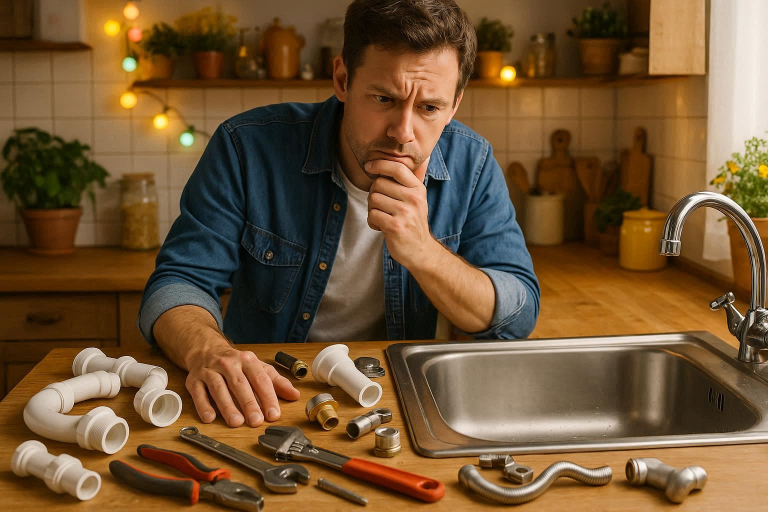There’s nothing more frustrating than turning on your kitchen sink to find that the water won’t flow. You’ve probably experienced that sinking feeling when you’re standing over the sink, expecting a stream of water, only to be met with complete silence. A kitchen sink that suddenly stops working is not just annoying—it can grind your daily routine to a halt, especially when you’re in the middle of cooking or cleaning.
Ignoring a non-working sink can lead to more significant issues, such as clogged pipes, water damage, or even potential plumbing emergencies. That’s why it’s important to address the problem quickly. In this blog post, we’ll dive into the most common causes of a kitchen sink that has stopped working and offer practical solutions to get your water flowing again. We’ll also help you understand when it’s time to call a professional plumber.
Common Causes for a Kitchen Sink Suddenly Stopping Working
Understanding why your kitchen sink suddenly stopped working is the first step to fixing the issue. Here are the top culprits:
Clogged Drain
A blocked drain is often the primary reason your kitchen sink might stop working. Over time, food scraps, grease, soap, and other Cleaning Guide for Home & Kitchen debris can build up inside the pipes, causing a blockage. This blockage prevents the water from flowing freely, which can lead to standing water in the sink.
Example: You may have noticed that your kitchen sink drains slowly before it eventually stops altogether. This is a classic sign of a clog.
Faulty Faucet
Another common cause is a malfunctioning faucet. The problem could be with the faucet valve, cartridge, or another internal component. Sometimes, a worn-out or damaged faucet will stop water flow completely, leaving you with no water coming out of the tap.
Example: If you try turning the faucet on and no water comes out, the faucet’s internal components might need a replacement or repair.
Water Supply Issue
A kitchen sink may also stop working due to a problem with the water supply. This could involve a shut-off valve that’s accidentally been turned off, a leak in the water line, or issues with the municipal water supply.
Example: If your sink has no water, but the rest of the house has water, the issue could be with your specific sink’s water supply.
Airlock in the Pipes
An airlock occurs when air becomes trapped in the pipes, blocking water flow. This can happen after the water supply has been turned off or after plumbing work. The trapped air causes a blockage, preventing water from flowing freely.
Example: You may notice water flowing intermittently or not at all, despite having no visible blockages.
Why Has My Kitchen Sink Suddenly Stopped Working?
If your kitchen sink has suddenly stopped working, it could be due to a variety of factors. Let’s explore some of the reasons why water might have stopped flowing unexpectedly:
Sudden Loss of Water Flow
The sudden loss of water flow is often a result of a clogged drain, malfunctioning faucet, or an issue with your water supply. The key is to isolate the problem by going through a step-by-step troubleshooting process.
Solution: Start by checking the faucet, followed by inspecting the water supply. If neither seems to be the issue, it’s time to check the drain and the pipes.
How to Diagnose the Problem
- Check the Faucet: Is the faucet valve working properly? If the faucet handle is stiff or the flow of water is erratic, the issue might lie within the faucet itself.
- Inspect the Drain: Run water in other sinks to see if the issue is isolated to the kitchen sink. If other sinks work, a drain clog is the likely cause.
- Look for Leaks: Check for any visible leaks in the water supply lines or around the faucet.
- Check the Water Supply: Verify that the water supply to the sink has not been turned off. If your house has a water filter or a separate shut-off valve for the kitchen, make sure they’re both open.
What Is a Problem That Makes Sinks Stop Working?
Several factors can cause your kitchen sink to stop working, and it’s important to understand what might be happening:
Clogged Drainage System
A blocked drain is the most common cause of water flow problems in a kitchen sink. Food waste, grease, and soap scum accumulate over time, forming a thick layer of debris that blocks water from draining. This can eventually lead to a complete blockage.
Solution: Use a plunger or drain cleaner to dislodge minor clogs. For more stubborn blockages, you may need to remove the drain trap or call a professional.
Faucet Malfunctions
The faucet itself could be the issue. Problems can occur with the aerator, valve, or cartridge inside the faucet. These parts wear down over time and may stop allowing water to flow correctly.
Solution: Check the faucet for any signs of malfunction. If the faucet is old or the parts seem worn, consider replacing the faulty components or the entire faucet.
Water Pressure Drop
Low water pressure can sometimes prevent the water from flowing properly from your kitchen sink. This can be caused by several factors, including a clogged aerator, a leak in the water supply line, or issues with the water supply itself.
Solution: Test the water pressure in other parts of the house. If the issue is only with the kitchen sink, it might be the aerator or a local issue with the plumbing.
Corroded Pipes or Leaks
Aging or damaged pipes can restrict the flow of water. Over time, pipes can corrode, develop leaks, or become clogged with sediment, which can stop water from reaching your kitchen sink.
Solution: Inspect the pipes for any visible damage or leaks. If you suspect corroded pipes, it’s time to call a professional plumber to replace or repair them.
Why Is There No Water Coming Out of My Kitchen Tap?
If you’re turning on the tap and there’s no water coming out, here are some potential causes and solutions:
Blocked Aerator
Over time, mineral buildup or debris can clog the aerator, which is the small screen at the tip of your faucet. This restricts water flow, causing the tap to produce weak or no water.
Solution: Unscrew the aerator and clean it. You can soak it in vinegar to remove mineral deposits or debris that could be blocking the flow.
Shut-off Valve Issues
If the shut-off valve for your kitchen sink has been turned off, no water will flow through the tap. This is often overlooked when a sink stops working, but it’s an easy fix.
Solution: Check the shut-off valve under the sink and ensure it’s turned all the way on.
Broken Faucet Cartridge
A worn-out or broken faucet cartridge can prevent water from flowing. The cartridge regulates the water flow inside the faucet, and when it fails, the water won’t come out.
Solution: Replace the faucet cartridge, which can often be done with basic tools. If you’re unsure how to do it, consider hiring a plumber.
Pipe Obstruction or Damage
Blockages or damage to the pipes leading to the faucet can prevent water from reaching the kitchen sink.
Solution: Inspect the pipes under the sink for any visible blockages or leaks. If you suspect a deeper issue, a plumber will need to diagnose and repair the problem.
Troubleshooting Tips for a Kitchen Sink That Won’t Work
Before calling a professional, try these troubleshooting tips to identify and resolve the issue with your kitchen sink:
Check the Faucet
Turn the faucet on and off to see if the water flow improves. If the faucet is stiff or the water flow is inconsistent, the issue may be with the faucet cartridge or valve.
Tip: Clean the aerator to eliminate any blockages caused by mineral buildup.
Inspect the Water Supply
Verify that the water supply has not been accidentally turned off. Check both the shut-off valve under the sink and any valves associated with the water filtration system or water heater.
Tip: If you suspect low water pressure, test other faucets in the house to see if the issue is isolated to the kitchen.
Examine the Drain
Check for visible blockages in the drain, such as food particles or grease buildup. Use a plunger or drain cleaner to dislodge any minor clogs.
Tip: For stubborn clogs, consider using a drain snake or auger to clear the drain further.
Flush the Pipes
Turn on all faucets in the house to help flush out any airlocks in the pipes. This can often restore water flow to your kitchen sink.
Tip: Use hot water to help clear minor blockages and air from the pipes.
Look for Leaks
Inspect the pipes under the sink for any visible leaks. Leaking pipes can reduce water pressure or stop the flow altogether.
Tip: If you notice a leak, consider replacing the damaged pipes or using plumbing tape as a temporary fix until a professional can repair it.
When to Call a Professional Plumber
If the DIY solutions above don’t work, it’s time to call a professional plumber. Here’s when you should seek expert help:
Persistent Issues
If the problem persists after trying the troubleshooting steps, there may be a deeper issue with the plumbing system. A plumber can perform a more thorough inspection.
Complex Pipe or Valve Problems
If the issue is related to complex internal pipework or a malfunctioning water valve, it’s best to call in a professional to avoid causing further damage.
Time Sensitivity
Some plumbing issues, such as leaks or problems with the water supply, require immediate attention to prevent extensive water damage to your kitchen and home.
How to Prevent Future Kitchen Sink Problems
Once you’ve fixed your kitchen sink, here are some preventive measures to avoid future issues:
Regular Maintenance
Regularly clean your kitchen sink and drains. Clear any food debris and avoid pouring grease down the drain. Periodic inspections can help catch small issues before they become big problems.
Proper Disposal of Food Scraps
Always dispose of food scraps in the trash or compost bin instead of down the sink. This will help keep the drain clear of potential blockages.
Using Drain Guards
Install drain guards to catch food particles, grease, and other debris that might clog your pipes. This simple addition can save you a lot of time and hassle.
Check Water Pressure Regularly
Ensure your home has adequate water pressure. Low water pressure can indicate an issue with the water supply, which may require a plumber’s attention.
FAQ
Why has my kitchen sink suddenly stopped working?
A clogged drain, faulty faucet, or issue with the water supply could be the cause. Start by checking for visible blockages or faucet issues.
What is a problem that makes sinks stop working?
Common causes include a blocked drain, faucet malfunction, low water pressure, or damaged pipes. Diagnosing the problem involves checking each component.
Why is there no water coming out of my kitchen tap?
No water flow could be due to a blocked aerator, an issue with the shut-off valve, or a problem with the faucet’s cartridge or internal components.
How do I fix a clogged kitchen sink?
Start by using a plunger or checking for visible blockages in the drain. If the clog persists, you may need to remove the drain trap or call a plumber.
When should I call a professional plumber for a kitchen sink issue?
If DIY fixes don’t work, or if the problem involves complex plumbing issues like pipe damage or a broken faucet, it’s time to call a professional.
Conclusion
A kitchen sink that stops working can disrupt your day, but it doesn’t have to be a headache. By following these troubleshooting tips, you can often identify and resolve the issue on your own. However, if the problem persists, it’s important to seek professional help to avoid further complications. Regular maintenance and careful attention to the sink’s components can prevent these issues from arising in the future.

